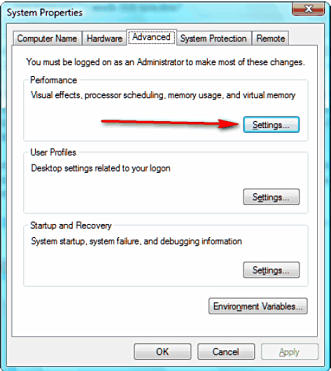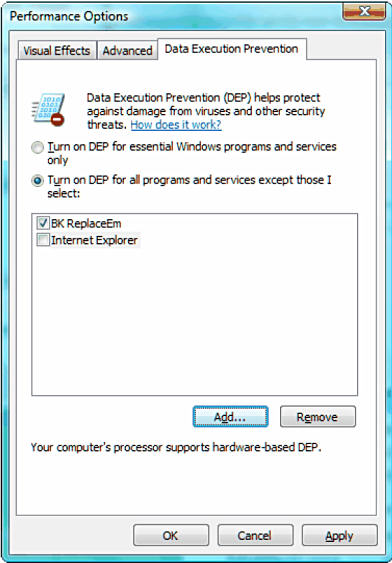
MASTERS ~ COMPUTER TIPS
Help for Plugins not working in WIN7
Submitted by Win - April 2012
MANY THANKS TO REBECCA FOR PERMISSION TO USE HER INFORMATION.
Here’s some information about the dlls and the DEP (Data Execution Prevention) and UAC (User Account Control)..
I got this from another group.. I don’t know if the instructions about administrative privilege works, as I have never had to do it...
but the other stuff about the DEP and UAC is helpful.
Cheers
Win
------------------------------------
How to get ADMINISTRATOR priviledges
There is a simple basic solution.... Restart your system.... as usual press F8 which will bring you into the "booting options" screen
Choose the SAFE MODE option, in a few seconds it automatically brings you in to two users login screen....
Your account and inbuilt Administrator account.
No password for the Administrator account ... just click it and you will be able to access - control panel - users accounts page.
Just change the account type to STANDARD User and that's it.
Restart your PC... enjoy.
WINDOWS 7 dll's (10 of them)
NOTE: You may need to be signed in on your computers Administrator account
INSTRUCTIONS FOR 32 BIT:
Unzip and put the dlls into your C:Windows System folder
and also
your C:Windows/System 32 folder. ALL 10 DLL's
INSTRUCTIONS FOR 64 BIT:
Unzip and put the dlls into your C:Windows System folder
and also
your C:Windows/SySWow64 folder. ALL 10 DLL's
********************************************************************************************
Keep in mind that making modifications to the two areas will have some effect on the Microsoft security features.
One is your DEP settings, the other is your UAC settings.
I recommend to my students that they have a firewall and anti virus program running at all times as well as current with all updates,
& that they keep their Windows updates current, anyway, and with the following changes it may be essential that you have these in place.
You as the user of your computer makes the decision, weigh the pros and cons, to decide as to whether or not you will make the changes
as indicated below.
Turn off DEP (Data Execution Protection) to prevent program crashes
Windows Vista and Windows 7
If you have a program you use and the program will not run or keeps crashing, sometimes it's
because Windows DEP (Data Execution Protection) keeps closing the program. If that's the
problem you're having, we're going to show you how you can prevent DEP from closing is so
you can continue to use that program.
But before we show you how to do that, you need to know why DEP is important and why you
shouldn't turn it off globally (for all programs).
Hackers and virus writers are always looking to exploit unpatched Windows vulnerabilities that
allow them to put data on a computer and then trick the computer into executing that data as if it
were normal program code. It's one way to take control of, compromise, or "infect" a computer.
Data Execution Prevention protects the operating system by trapping malicious attempts to
execute data as if it were program code. It's been proven since Windows XP to be a very way to
block malicious code from executing. But, like all things, there are two side to that coin - some
legitimate programs execute data as code, especially older ones and some newer ones which
were created before DEP became part of Windows (with the release of Windows XP) and which
were simply updated to work with Windows XP and newer versions of Windows.
But... if you have a program you trust that also happens to cause DEP errors, you can add it to
the list of exceptions and effectively turn DEP off for that program. Assuming your computer is
protected with good antivirus and good antispyware (and you keep them updated) you shouldn't
be increasing your risk of being "attacked" by malicious code simply because you turned DEP
off for a particular program or two.
In Windows Vista or Windows 7 you can access the DEP dialog by right-clicking "Computer" in
the start menu (or on the desktop) and choosing "Properties". In the dialog that appears, click the
Advanced tab. Under Performance, click "Settings".

Now click the Data Execution Prevention tab.

In the image above you can see that there are two ways to turn off DEP.
The first way is to "Turn on DEP for essential Windows Programs and services only" and the second is "Turn on
DEP for all programs and services except those I select."
Rather than turning off DEP for
everything except essential Windows programs and services, a better (and safer) way to fix
DEP errors with programs is to add those program (or program) to the exception list.
Here’s how to add PSP to the exception list.
It's easy to do. Click on the Add... button.
Now,
browse to the program's executable (exe) file. If you have more than one program causing DEP
errors and which is being shut down by DEP add it to the list also. But remember - only add
programs to the exception list that you know are safe and that you trust. And make sure you
have good antivirus and antispyware programs running on your computer and you keep them
updated.
If your program crashes or freezes were due to Windows DEP (Data Execution Protection) then
the information provided here will allow you to run the program normally. If you follow the
steps above and the program still won't run, then it wasn't DEP that was causing the problem.
However, much of the time programs that crash or freeze on Vista and Windows 7, crash or
freeze because of Windows' DEP.
Next is the UAC. This is where when I made the changes, that it really had an effect on my PSP
X2 and the plugins I have had issues with (Xenofex 1, Ulead's, and Eye Candy 3.1 for all version
of PSP that I am running)
UAC - stands for User Account Control.
This is a security feature of Windows 7, and I think Vista (again will be able to say for sure with
more feedback for users of XP and Vista) to prevent harmful programs from making changes to
your computer.
To locate this, activate your Control Panel from the Start menu
Look for User Accounts and Family Safety and click on the words "User Accounts and Family
Safety"
In the next screen click on "User Accounts", again click on the words, not the options that are
available.
In the white area of the main screen, at the very bottom is "Change User Account settings"
Click it
A screen with a slider bar on the left side will come up.
The top of the slider bar is "Always
Notify", and the bottom is Never Notify.
In between both are two (2) more settings. Mine was
defaulted to the 2nd from the top.
Slide this slider all the way to the bottom; "Never Notify" (The display on the right side will tell
what the settings do for your security if you decide to change to it)
Click OK.
You will have to Restart your computer at this point for the change to go into effect.
Once your computer has restarted, open PSP. For me, the plugins I had problems with were
working, and I hope they will be for you as well.
INDEX
Page designed by Jemima for
Artistry in PSP.
Artistry in PSP was created by using Paint Shop
Pro 7
Copyright: Jemima © 2003/2012

All rights reserved.
No portion of this site or it's
links may be removed (graphics or text),
without the expressed permission of Artistry
in PSP,
unless specifically offered as a download
|